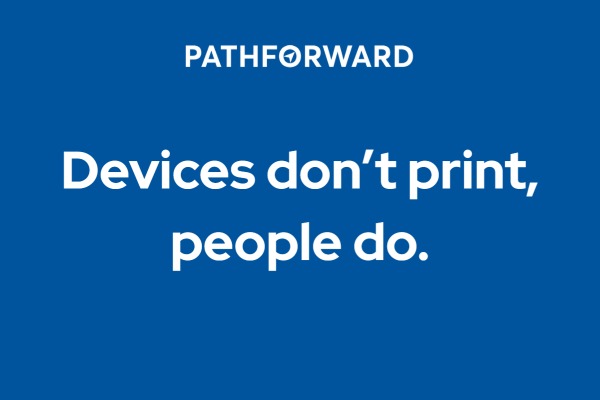This is an edited version of a speech titled “The View From Heaven”, delivered by our founder Keith Nickoloff at an industry conference in 2018.
In this blog, I will attempt to offer you a point-of-view about three questions that will define the future of printing and shape the direction of our professional lives:
- What direction is the world headed?
- What is the impact of that direction on enterprise printing?
- What are some of the healthiest actions we can take in printing in response to this direction?
One way we are doing that is by paying attention to the choices we’re making, why we’re making them, and the impact of those choices on ourselves and the world around us. This activity––to continually pay attention means to think big. Think comprehensively about the impact of our choices––today, tomorrow, and beyond.

Keith Nickoloff
President
But how does this take place in the world of enterprise printing? Here are a few of our real-world examples.
At PathForward, one of our early customers is an extremely well-known global brand. As clean water becomes an even more precious resource, they have become very sensitive to the amount of water they use around the world. But, water is directly related to the production of paper, and the production of paper is directly related to the harvesting of trees. The use of trees and water, which together contribute significantly to a healthy planet, is impacted by printing. And printing is impacted, more than anything else, by paying attention.
With a little help from PathForward, this organization consumes the equivalent of 60% fewer acres of trees than it did 5 years ago. Do you see the environmental impact of what “paying attention” can do? A sustained reduction in printing-related costs of more than 40% over the past 5 years.
What can you take away from these stories? That paying attention can help drive intelligent decision-making. The common sense necessary to make these decisions is rooted in six principles that we feel will have a profound impact on the future of enterprise printing.
1. All real change begins with commitment.
Whether printing happens in your office, with hybrid workers, in a print shop, data, print, and mail operation, or is out-sourced, senior management understands the cost of not having an integrated, enterprise-wide print strategy that is based upon a comprehensive understanding of who’s printing, why, how, what, and the price paid for it. These costs drive organizations to make a commitment to intelligent printing as part of their culture – which can result in 35-65% savings in the short term. But for long-term benefits, there has to be an overall shift in mindset.
2. Solve the biggest problem you can.
Start off by understanding everything that influences printing decisions and costs. That can include every person, every desktop, every department, every relationship, every contract, every invoice, every job ticket, every place print occurs, and the insights of users, management, and benchmarks from comparable organizations.
Since a complex array of factors influence an institution’s approach to printing, understanding those factors, and their interrelationships with one another, is vital to developing a strategy that has the greatest, most sustainable, long-term benefit.
In our experience, such a strategy can have some pretty remarkable results. It is not uncommon for us to meet organizations with a workforce of 25,000 that tell us they would like to save 1 to 2 million dollars a year in print. We smile and say, “That’s wonderful. But how would you like to save $10 to $12 million a year?” Because, here at PathForward, we have found that when companies of 25,000 people start really paying attention, $10 million a year in savings is very doable.

Here’s another fact: Utilization is the key ingredient to improving the total cost of operation (TCO) involved in all three print environments. And the key to utilization is understanding (and achieving) the minimum number of prints for optimum efficiency. Nowhere is this more sensitive than in the inplant production environment. Whenever monthly utilization is less than 1.5 million black and white clicks, the per-copy cost of labor in the print shop alone is more than the cost of a typical click in the office. Curiously, among the reasons this inefficiency occurs in many in-plants (where, with the right volume, the least expensive printing should occur) is the habit of chargebacks. This practice, we have found, discourages colleagues from using the most secure and efficient location to print: the in-plant, printing instead in the office where printing appears to be “free” but is among the more expensive option. These are the kinds of considerations that are illuminated with a commitment to address the biggest possible picture.
3. Devices don’t print, people do.
And too often, print is driven by habit rather than by principles. There are many examples of this, beginning with legacy systems designed to crank out continuous pin-feed “green bar” computer-printed reports even if the world were to come to an end. The objective is not necessarily to print less but to make every print an intelligent decision. Do that, and the volume of printing, how those prints are produced, and the cost of that production, will follow accordingly.
4. Printing as we know it is a pain in the neck for IT professionals.
Any initiatives to make more intelligent printing decisions must make the IT professional’s life easier and make the IT infrastructure simpler.

5. By and large, colleagues will do their best to meet the expectations of management.
In our experience, motivation is seldom the barrier to making intelligent printing decisions. Normally, a person’s natural instincts lead them to act in a manner that serves the well-being of the organizations to which they belong. Of course, to do so they must be aware of what is required and feel they have the means to achieve it. This makes it imperative that what’s expected is reasonable, well defined, and clearly communicated.
6. Changing behavior requires monitoring expectations and communicating progress.
This means helping users understand how their printing behavior compares to expectations, compares to the behavior of their peers––and, how it impacts the bigger picture.
One of our banking clients consistently achieves >40% reduction in print by instituting a few simple procedures. Every colleague knows their print choices are being monitored. Every day a list of the top 10 print uses is published, not to discourage printing, but to encourage thoughtful choices. Plus, first-level managers receive a range of useful information, including usage trends and comparisons among team members, and the environmental impact, such as paper, water, and trees preserved, along with solid waste, CO2, and electricity.
These principles are surely not the last word in paying attention, but their impact on making every print an intelligent decision grows more significant by the day.
Take IT Forensics, for instance. While the name might sound like a popular TV series, for a growing number of companies around the world, perhaps nothing is more important.
Remember I said, devices don’t print, people do? Of those employees suspected of illegal behavior, we tracked their every copy, scan, and fax––and recreated every incidence of print. Arrests and convictions followed.
An event not quite so potentially dangerous, but equally bizarre, occurred when Oprah interviewed financial counselor, Suze Orman, and during the course of that interview announced that a copy of Orman’s latest book could be downloaded from Oprah’s website…for free. Turns out that an employee for one of our customers not only downloaded the book––some 352 pages––but also printed it, twice, in color, on a personal inkjet device, single-sided, at a cost to the company of more than $300…per book. Fortunately, the tracking system we had in place flagged that event and allowed us to prevent anyone else from printing a book they could buy from Amazon for $14.92.

A financial services company asked PathForward to assess their internal statement printing operation. We came back with bad news, worse news, good news, and great news. The bad news was they were paying for millions of clicks they weren’t using – never buy or get stuck with “minimums”. The worse news was they’d been doing so for almost 4 years. The good news was they now knew it. And the great news was we could help them negotiate and rightsize their equipment contract.
One of our customers has more than 300,000 employees in North America, using 25,000 print devices across 3,000 locations. As a result, this client had to manage more than 100,000 print queues. They came to us and said, “We don’t want to manage 100,000 print queues. We want a single print queue. What can you do?” Our answer: maybe not one, but how about two print queues – one for mono and one for color?
How is this possible? As the industry begins to innovate, look to the cloud to help simplify your IT print infrastructure: look at print servers, print queues, print drivers, single-sign-on, and more, especially in the areas of cyber-security, work-from-home, and many more.
We in the world of printing are engaged in a grand adventure. Almost every discipline on earth rooted in technology has changed dramatically in the last 25 years. One major exception is printing. The dramatic changes in our world are just beginning to take place. Keep learning, share what you learn, and most importantly, pay attention.
Take The First Step
If you’re not thinking about your print strategy holistically, you may be paying millions of dollars more every year than needed. However, developing a strategy and utilization of fixed assets can lead to an enterprise saving between 35-65%.
If you are interested in these types of savings and driving bottom-line impact, the model below is how and what PathForward does in helping organizations like yours find the best-tailored strategy for their goals, priorities, and requirements.
We have helped organizations like yours save over $750M.
